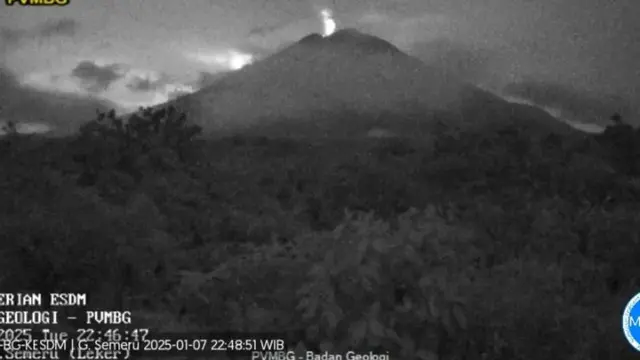Lumajang – Mount Semeru, the highest mountain on the island of Java, erupted again, with an eruption height reaching 600 meters above the summit on Tuesday night (7/1/2025).
“An eruption of Mount Semeru occurred on Tuesday night at 10:46 PM WIB,” said Liswanto, an officer at the Mount Semeru Observation Post, on Wednesday (1/8/2025).
According to him, the height of the eruption column was observed to be around 600 meters above the peak or 4,276 meters above sea level.
“The ash column was observed to be white to gray with moderate intensity towards the southwest.” At the time the report was made, the eruption was still ongoing,” he explained.
Previously, officers recorded that the mountain, which directly borders Lumajang Regency and Malang Regency, had already experienced 17 eruptions on Tuesday since 02:07 WIB with an eruption height of 600 meters above the summit and the latest eruption at 22:46 WIB.

The mountain, which has an elevation of 3,676 meters above sea level, is still on alert status, so the Center for Volcanology and Geological Hazard Mitigation (PVMBG) has issued several recommendations, namely that the public is prohibited from carrying out any activities in the southeastern sector along Besuk Kobokan up to eight kilometers from the summit (eruption center).
Outside that distance, the public is prohibited from engaging in activities within 500 meters from the riverbank (river boundary) along Besuk Kobokan, as it is at risk of being affected by the expansion of hot clouds and lahar flows up to 13 kilometers from the peak.
“The public is also not allowed to engage in activities within a 3-kilometer radius from the crater/summit of Mount Semeru, as it is prone to the danger of incandescent rock eruptions,” he said.
In addition, the public also needs to be wary of the potential for pyroclastic flows, lava flows, and cold lava due to rain along the river/valley flows originating from the summit of Mount Semeru, especially along Besuk Kobokan, Besuk Bang, Besuk Kembar, and Besuk Sat, as well as the potential for lahars in the small rivers that are tributaries of Besuk Kobokan.






Leave a Reply